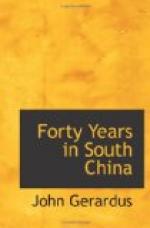The answers to these questions have been as various as the denominations represented in Oriental lands. The answers of missionaries representing the same denomination have not even tallied.
After the gracious awakening and ingathering at Amoy and in the region about, had taken place, the question of church organization became foremost. The missionaries gave the subject earnest thought. Men like Elihu Doty and John Van Nest Talmage and Carstairs Douglas, were not likely to come to conclusions hastily.
But they were born pioneers. Conservative enough never to lose their equilibrium, they had adaptability to new circumstances.
Quite willing to follow the beaten path so long as there was promise of harvest returns, they were prepared nevertheless to blaze a new road into the trackless forest if they were sure some of God’s treasure-trove could be brought back on it. There was no divergence of view as to what the foundation of the new church-structure must be. ’For other foundation can no man lay than that which is laid, which is Jesus Christ.’ So long, however, as the general proportions were the same, there was no fear that the new edifice would topple over if it did not conform exactly in height and length and breadth, in column and pilaster and facade, to the venerated model in the mother countries. The brethren expressed their views to the churches in the home land. They did more. They plead their cause and hoped for endorsement. The following is part of a lengthy but very interesting communication written by Mr. Talmage and sent to the Synod of the Reformed Church in 1856:
“Amoy, China, Sept. 17, 1856.
“To the General Synod of the Reformed Protestant Dutch Church.
“Fathers and Brethren: We your missionaries at Amoy, China, have, by the blessing of the Head of the Church on our labors, arrived at a stage of progress in our work which imposes on us weighty responsibilities, and we feel the need of counsel and advice. It will be proper for us to give a brief account of our Mission, of our work, of the blessing of God on our labors, of our peculiar circumstances, and of the principles on which we have acted hitherto, and which we think should still guide us in our efforts to establish the Kingdom of Christ in this land, that you may praise God in our behalf and in behalf of this people, and assist us by your sympathies, prayers, and counsels. Our Mission was commenced at Amoy by the late Rev. David Abeel, D.D. Mr. Abeel arrived at Amoy in company with the Rev. (now Bishop) Boone, on the 24th of February, 1842. On the 22d of June, 1844, Rev. E. Doty and Rev. Wm. J. Pohlman arrived at Amoy from Borneo. In Dec., 1844, Mr. Abeel in consequence of continued and increasing ill health left Amoy on his return to the United States. Mrs. Pohlman and Mrs. Doty having been removed by death, Mr. Doty left Amoy for the United States, Nov. 12, 1845, with his own and Mr. Pohlman’s children. Rev. J. V. N. Talmage accompanied Mr. Doty on his return to Amoy, arriving Aug. 19, 1847. Mr. Pohlman was lost at sea Jan. 5, or 6, 1849. Mr. Talmage was away from Amoy from March 24, 1849 to July 16, 1850. Rev. J. Joralmon arrived at Amoy, April 21, 1856.




